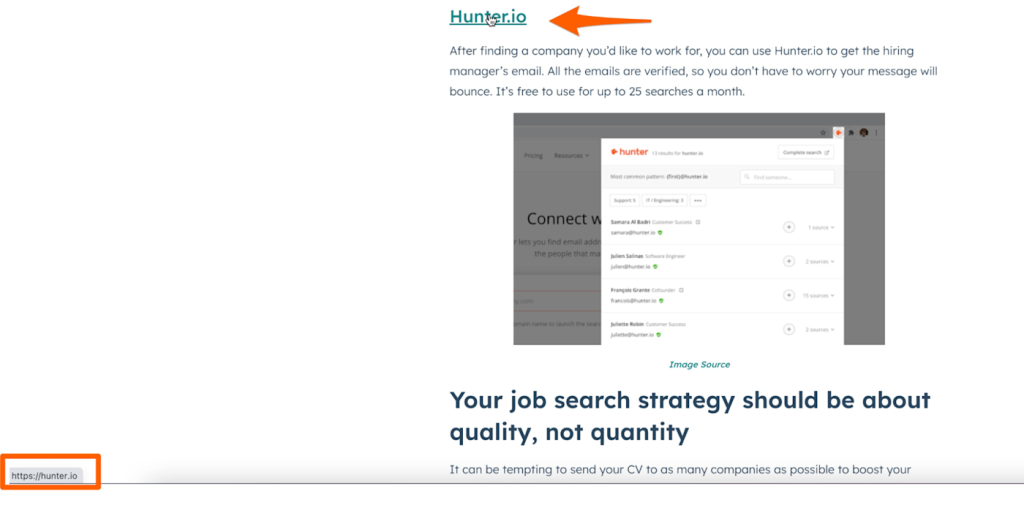Backlinks remain the backbone of SEO and play a crucial role in search engine rankings. Not all backlinks, however, are created equal. Search engines value quality over quantity, and websites with high-quality, relevant backlinks are those that achieve top rankings on Google.
But how do you go about building these sought-after links in 2025? This ultimate guide walks you through 15 proven strategies to secure high-quality backlinks, complete with actionable examples.
What Are Backlinks and Why Do They Matter?
A backlink is a link from one website to another. Think of backlinks as votes of confidence for your site—when another website links to yours, it’s essentially telling search engines, “This is credible and worth visiting.” Backlinks play a massive role in helping your pages rank higher in search results. If you’re wondering how to get backlinks, focus on creating valuable content, building relationships with other sites, and leveraging guest posting opportunities.
Types of Backlinks
- DoFollow Backlinks: Transfer link authority (or link juice) and directly affect rankings.
- NoFollow Backlinks: Don’t pass authority but can still drive referral traffic.
What Makes a Backlink High-Quality?
- Relevance: The linking site should align with your industry or niche.
- Authority: Backlinks from high Domain Authority (DA) websites carry more weight.
- Placement: Links placed naturally within the content (not in sidebars or footers) are more valuable.
- Anchor Text: The clickable text of the link should be relevant to the content it’s linking to.
Understand Domain Authority Before You Start
Domain Authority (DA), developed by Moz, is a metric that scores a website’s ability to rank in search engine results. Sites with a high DA (like Forbes or The New York Times) provide stronger backlinks.
How to Check Domain Authority
Use tools like Moz, Ahrefs, or SEMrush to assess the DA of potential backlink sources. Focus on targeting sites with a DA of 40 or higher for more impactful results.
1. Foundational Link-Building Strategies (Start Here)
To succeed in link-building, it’s essential to master the basics before moving on to advanced techniques. Here are some beginner-friendly tactics you can start with:
Guest Blogging
Guest blogging is an effective way to enhance your online visibility and boost SEO.
- What to Do: Write informative, high-quality articles for reputable websites in your niche, including a backlink to your site.
- Pro Tip: Focus on niche-specific websites rather than general blogs to secure higher-quality links.
- Example: HubSpot has successfully built authority by contributing guest posts on topics like SEO and digital marketing to well-known websites like Search Engine Journal. This strategy has strengthened their backlink profile and reinforced their expertise.

Local Citations and Online Directories
Consistent business information across online directories helps improve local SEO and build customer trust.
- Examples: Platforms like Google My Business, Yelp, and other industry-specific directories are great starting points.
- Pro Tip: Ensure that your business name, address, and phone number (NAP) are consistent across all listings.
- Example: A Seattle coffee shop updated its Google My Business and Yelp profiles with accurate details and new photos. Within three months, they experienced a 35% boost in foot traffic due to better online visibility.
- Why It Matters: Accurate listings not only enhance local SEO rankings but also increase customer trust, making your business a preferred choice.
Start building a strong foundation with these simple yet impactful strategies today!

Turn Brand Mentions into Backlinks: Step-by-Step Process
- Set Up Alerts: Use tools like Google Alerts or Ahrefs. Enter your brand name and set up notifications to track when your brand is mentioned online.
- Identify Unlinked Mentions: Review the mentions you’ve tracked to see which ones don’t include a link to your website.
- Find Contact Information: Locate the contact details of the website owner or editor. This information is often available on their “Contact” page or through a WHOIS lookup.
- Craft a Polite Outreach Email: Write a friendly, professional email. Acknowledge their mention of your brand, thank them for it, and politely request that they add a link to your website for their readers’ convenience.
- Follow Up: If you don’t receive a response within a week or two, send a polite follow-up email to ensure your request hasn’t been overlooked.
- Track New Backlinks: Use your tracking tool to monitor whether the website has added the link. Celebrate your new backlink when it’s live!

Reclaim Broken Links: A Simple Guide
- Find Websites in Your Industry – Make a list of sites in your niche that could link to your content.
- Locate Broken Links – Use tools like SEMrush or Broken Link Checker to find broken links on those sites.
- Check for Relevance – Look at the broken links and see if your content could be a good fit as a replacement.
- Create or Update Content – Make sure you have quality content that matches the topic of the broken links.
- Reach Out – Contact the site owner, let them know about the broken link, and politely suggest your content as a replacement.
- Follow Up – If you don’t get a response, send a quick follow-up to check in.
This approach helps you earn backlinks while improving the experience on other websites.

2. Content-Based Backlink Strategies That Work
To attract high-quality backlinks, focus on creating valuable, link-worthy content. Here are some effective strategies on how to get backlinks:
Skyscraper Technique
This proven method helps increase traffic and earn backlinks for your website. Here’s how to apply it:
- Identify Popular Content: Find top-ranking articles in your niche that already have strong traffic and backlinks.
- Enhance the Content: Develop a new piece that improves on the original by adding depth, updating facts, including visuals, or presenting the information in a more engaging way.
- Promote Your Work: Contact websites linking to the original content and share your improved version, explaining how it provides extra value.
Example: A tech blog noticed a popular article titled “Top 10 Productivity Apps.” To stand out and demonstrate how to build backlinks, they created “50 Productivity Apps to Supercharge Your Workflow,” featuring detailed reviews and actionable tips. By reaching out to sites linking to the original, they secured hundreds of backlinks and boosted their traffic.
Infographics and Visual Content
Infographics are a powerful way to simplify complex ideas in an engaging, shareable format. They’re often referenced by other sites, which can help you earn backlinks in SEO. Add an embed code to make sharing easy while ensuring credit.
Quick Tip: Keep designs clean and visually appealing, avoiding overcrowding. Tools like Canva or Adobe Express can help. For example, if explaining a process, use a clear step-by-step flowchart with bold colors and labels. Always include your logo and website link to ensure proper attribution when shared.

Create Data-Driven Original Research
Publishing unique, data-backed research is a powerful way to attract links and establish authority. By sharing original studies, surveys, or data reports, you provide valuable insights that others will want to reference, increasing the likelihood of earning backlinks. High-quality, reliable data encourages other sites to credit and link to your work.
Steps to Create Data-Driven Research:
- Choose a Relevant Topic: Focus on a subject that resonates with your industry or audience and hasn’t been widely explored.
- Gather Credible Data: Use tools like surveys, interviews, or existing datasets to collect meaningful and accurate information.
- Analyze and Interpret: Break down the data into clear insights, looking for trends or surprising findings that your audience will appreciate.
- Make It Visual: Use charts, graphs, or infographics to simplify complex information and make your data more engaging.
- Publish and Share: Post your research on your site, share it across social media, and reach out to relevant websites or journalists to encourage links back to your work.

Interactive Tools and Templates
Interactive tools and templates are practical resources designed to help users accomplish tasks or solve problems more efficiently. These tools engage users by providing hands-on functionality and actionable outputs, adding value to their experience.
Examples:
- Calculators: Tools like mortgage calculators, ROI calculators, or calorie trackers that help users compute specific outcomes based on input data.
- Templates: Pre-designed layouts or formats, such as resume templates, business plan templates, or social media content calendars, that save users time and effort.
- How-to Checklists: Step-by-step guides for tasks like setting up a website, planning an event, or preparing for a job interview, ensuring users don’t miss any crucial steps.
These resources empower users by simplifying complex tasks and delivering immediate, tangible benefits.
Book a demo with SaaSKnot today and start building powerful backlinks effortlessly!
Expert Roundup Posts: A Powerful Content Strategy
Expert roundup posts are collaborative articles where industry professionals share their insights on a specific topic. These posts not only provide valuable content for your audience but also increase your reach, as contributors are likely to share and link back to your post. Here’s how they work and some examples to inspire you:
What They Are:
An expert roundup brings together quotes, tips, or opinions from multiple experts in your industry. For example, instead of just listing marketing tips yourself, you could ask 10 well-known marketers to share their favorite strategies. This adds credibility, depth, and diversity to your content.
Why They Work:
- They create shareable content that experts will promote to their audiences.
- They position your brand as a connector in your industry.
- They drive organic backlinks, boosting SEO.
Examples of Expert Roundup Posts:
- Compliance Roundup – Recent Violations from Across the Country
- SEO Roundup 2024 — A Year in Review!
- Moburst’s 2024 Marketing Roundup & 2025 Predictions #20

By collaborating with experts, you can create high-value content that boosts engagement and visibility for your website or blog. Start reaching out to thought leaders in your field and see how impactful this strategy can be!
3. Smart Competitive Analysis Techniques
Understanding your competitors’ backlink strategy can help inform your own.
Reverse-Engineer Competitor Backlinks
Analyzing your competitors’ backlinks in SEO is a powerful way to uncover link-building opportunities and improve your SEO strategy. Here’s how you can do it effectively:
- Choose Competitors to Analyze
Identify 2-3 top competitors in your niche whose websites rank well for the keywords you’re targeting. These websites serve as benchmarks for your backlink analysis.
- Use Backlink Analysis Tools
Tools like Ahrefs, SEMrush, or Ubersuggest can help you analyze your competitors’ backlink profiles. Enter their domain into the tool to generate a list of websites linking to their content.
- Evaluate Link Quality
Focus on high-quality backlinks from authoritative domains. Look for consistent themes or patterns in the types of content attracting these links, such as blog posts, guides, or tools.
- Create a Winning Pitch
Reach out to the websites linking to your competitors with a tailored pitch. Highlight what makes your content valuable or suggest a specific resource on your website that could be a better or additional fit for their audience.
By following these steps, you can replicate successful backlink strategies and build a stronger link profile for your website.
Anchor Text Strategy
To improve your link-building efforts, take a closer look at the anchor texts your competitors are using for their backlinks. Here’s how you can do it:
- Find Patterns: Pay attention to the types of anchor texts they use, such as exact match, partial match, branded terms, or generic phrases like “click here.” For example, if many of their backlinks include product-related terms like “best SEO tools,” that could highlight a keyword worth targeting.
- Identify Gaps: If your competitors are earning backlinks with branded terms like “XYZ Tools,” but your brand name isn’t getting the same attention, it might be time to focus on building your brand through outreach and partnerships.
- Avoid Overdoing It: If their anchor text strategy includes a mix of specific keywords like “how to improve SEO rankings” and generic phrases like “visit this site,” it shows the importance of maintaining variety in your own strategy to avoid search engine penalties.
- Use Contextual Phrases: Notice if they’re using natural phrases such as “comprehensive guide to SEO” in their backlinks. This could inspire you to create similar content and reach out to websites for link-building opportunities.
By analyzing these trends, you’ll gain insights to develop a balanced and effective anchor text strategy that supports your SEO goals.
4. Relationship-Driven Link Building
Building backlinks isn’t just about SEO—it’s about relationships.
Build Relationships Before Asking
- Share blog posts from industry leaders on social media.
- Leave thoughtful comments on their blogs or LinkedIn posts to start a genuine connection.
Join Industry Forums
Participate in niche forums or communities where your target audience is active. Share your expertise, and when appropriate, link to your site.

Leverage Your Network
Ask vendors, partners, or collaborators to link to your site on their websites. You can also secure backlinks via client testimonials.
5. Outreach That Doesn’t Suck
Backlink outreach often fails because the emails feel generic and salesy.
What a Good Outreach Pitch Looks Like
- Personalization: Reference their website or a specific post they’ve written.
- Value Add: Offer something that genuinely benefits their readers.
- Be Brief: Short, concise emails perform better than long-winded ones.
Example Outreach Email:
Hi [Name],
I noticed your post on [Topic] and found it incredibly insightful! I recently published a piece on [Related Topic] that could be a useful addition to your article as a resource for readers. Here’s the link in case you’d like to check it out [Link].
Best,
[Your Name]You can outsource this hustle and let us build links for you—book a quick demo.
PR & Media-Focused Link Building
Before diving into advanced techniques, use these media-focused strategies to build quality links:
Respond to HARO Requests
What to Do: Sign up for HARO or Qwoted to provide expert quotes or insights in exchange for backlinks.
Pro Tip: Respond to requests promptly and tailor your submissions to the reporter’s needs.
Get Featured in “Best of” Lists
What to Do: Reach out to journalists or bloggers who create “best [product/service]” lists and pitch your offering.
Pro Tip: Highlight what sets your product or service apart to increase your chances of being featured.
Turn Unlinked Brand Mentions into Backlinks
Identifying unlinked brand mentions is a great way to build backlinks quickly and efficiently. Many websites might mention your brand but fail to include a link to your site.
What to Do: Use tools like BrandMentions, BuzzSumo, Google Alerts, or SaaSKnot to track mentions of your brand online. Once identified, reach out to the site owners or authors and politely request they add a link to your website.
Pro Tip: When reaching out, highlight the value of linking back to your site, such as providing additional resources or enhancing user experience. A personalized and friendly approach increases the chances of success.
Why It Works: These are already warm leads—they’re familiar with your brand and likely happy to support with a link. This strategy not only improves SEO but also strengthens relationships with other websites in your industry.

Social Media + Backlinks = Power Combo
Social media may not directly impact SEO, but it’s invaluable for amplifying link-worthy content and driving traffic that ultimately enhances your backlink profile. Here’s how to make the most of this powerful combination:
Share Content on Social Media
What to Do: Share blog posts, case studies, or infographics on platforms like LinkedIn, Twitter, and Facebook with compelling captions that grab attention.
Real-Life Example: A SaaS company shares an article on LinkedIn titled “5 Solutions to Boost Productivity,” tagging influencers who contributed quotes. The post garners shares and backlinks from others in the industry.
Engage Your Audience
What to Do: Tag businesses, collaborators, or influencers featured in your content to encourage resharing and backlink opportunities.
Real-Life Example: A local coffee shop posts an Instagram story tagging the roasters they partner with. The roasters then share the post, linking back to the original on their blog.
Leverage Viral Content
What to Do: Create sharable, engaging content like quizzes, videos, or how-to guides that naturally attract attention and links.
Real-Life Example: A travel blogger creates a quiz, “Which Destination Matches Your Personality?” and shares it on Facebook. It goes viral, showcasing how to build backlinks by earning links from multiple travel websites.
Join Relevant Social Media Discussions
What to Do: Participate in Twitter chats, LinkedIn groups, or Reddit threads related to your industry. Share useful content that includes backlinks to your site.
Real-Life Example: A Link Building agency joins a LinkedIn group discussion about SEO strategies and shares their blog post on “Top 10 Link-Building Tactics.” This generates traffic and inspires others to link back.
By combining social media engagement with a solid strategy for promoting link-worthy content, you can organically grow your backlinks while increasing your content’s visibility.
Actionable Step for 2025
Building backlinks takes time, consistency, and strategy. Follow these techniques, analyze your results, and adjust. Remember, quality always trumps quantity in today’s SEO world.
Sign up for tools like SEMrush or Ahrefs today to kickstart a smarter backlink strategy. Or, let SaaSKnot do the heavy lifting for you—get high-quality backlinks effortlessly with our platform.




